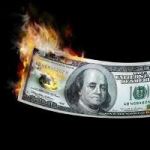 Fed Chair Jerome Powell recently stated quantitative tightening is about to end. What’s more, this will happen well before the Fed’s balance sheet ever gets close to $4 trillion, which is where it was prior to the coronavirus money printing festival.
Fed Chair Jerome Powell recently stated quantitative tightening is about to end. What’s more, this will happen well before the Fed’s balance sheet ever gets close to $4 trillion, which is where it was prior to the coronavirus money printing festival.
If you recall, between 2020 and 2022 the Fed spiked its balance sheet to $8.9 trillion. To do so it created credit out of thin air and loaned it to the U.S. Treasury through purchases of Treasury securities. This process is known as quantitative easing.
The Treasury used the debt infusions to send out round after round of stimmy checks, among other things. This drove consumer price inflation to 40-year highs.
Any hope consumer prices would ever return to their pre-2020 level is gone. Over the last three years the Fed has brought its balance sheet down to about $6.6 trillion. Now it’s throwing in the towel before the job is even halfway done.
Last week, while speaking at the National Association for Business Economics conference in Philadelphia, Powell said:
“Our long-stated plan is to stop balance sheet runoff when reserves are somewhat above the level we judge consistent with ample reserves conditions. We may approach that point in coming months…
“Normalizing the size of our balance sheet does not mean going back to the balance sheet we had before the pandemic. In the longer run, the size of our balance sheet is determined by the public’s demand for our liabilities rather than our pandemic-related asset purchases.”
The end of quantitative tightening will happen on the heels of Fed rate cuts. Then, it’s only a matter of time before the Fed returns to balance sheet expansion through quantitative easing.
This time, however, a renewed balance sheet expansion will be kicking off from $6.6 trillion instead of $4 trillion. Thus, by the end of the decade consumer prices will be at levels that make today’s prices look cheap.
What gives?
Kicking the Can
For central planners and big government statists, inflation is the ultimate short-term expedience. It’s the economic equivalent of hitting the snooze button. It feels great in the moment. But it only delays the inevitable chaos. In short, inflationary fiscal and monetary policies are incredibly hard to resist because they offer an easy way out of immediate problems.
Central planners love the path of least resistance. When faced with unfavorable conditions, like a looming recession or a budget shortfall, the urge to print money, keep interest rates artificially low, or run budget deficits, is alluring. It provides a temporary fix to difficult problems.
Inflation is always the central planner’s go to answer. It offers short-term relief in exchange for long-term devastation. By kicking the can down the road central planners can delay the pain until after they’ve exited their jobs. They put off the problem and leave it for the next guy to deal with.
For example, say the economy is slowing and the unemployment rate is rising. Central planners could make the difficult choice to allow the market to adjust. They could also address underlying structural issues like excessive regulations and taxes.
This approach typically takes time and hard work in the form of a recession or depression before the recovery occurs. It requires allowing things to get worse before they get better. This is painful and politically unpopular even though it supports long term health of the economy.
The expedient approach, the way preferred by central planners, is to inject new money into the system – through artificially low interest rates or Fed asset purchases – to quickly stimulate demand. This supports struggling businesses and may delay a credit crisis. Politicians also get to keep their jobs.
Duct Tape
Inflation acts as a silent, invisible lubricant, temporarily greasing the gears of the economy. It allows the government to fund its projects, pay its debts, and bail out specific sectors without the politically painful necessity of raising taxes or making spending cuts.
For private businesses, it makes borrowing cheaper, which encourages expansion and investment, even for projects that aren’t fundamentally sound. It allows both government and business to bypass the realities of their poor decisions and poor policies.
Instead of having to accept and adjust to conditions where current spending is unsustainable, the government and the economy rely on the central bank to create additional money and credit. The central bank, in the case of the U.S. the Federal Reserve, enables the buildup of debt and inflation.
These policies of dollar debasement are used to paper-over mistakes. Inflation becomes the duct tape applied to the economy’s structural cracks. Unfortunately, this doesn’t solve the problem. In fact, it allows the problem to grow larger and ultimately more destructive.
At the same time, it distorts prices throughout the economy. For example, five years ago the Fed printed gobs of money in response to the self-inflicted damage of the coronavirus lockdowns. The economy is now dependent on that additional money supply. It cannot be reeled in without causing a credit crisis and a painful recession. This is why the Fed cannot return its balance sheet to $4 trillion.
We’ve seen this happen several times this century. The Fed issued cheap credit to soften the consequences of the dot com crash in the early 2000s, and we ended up with a destructive housing bubble. The housing bubble crashed and the Fed, through quantitative easing and zero interest rate policy, puffed countless speculative bubbles, including stocks, houses, and cryptocurrencies.
Dollar Debasement as Permanent Policy
After each of these episodes, the Fed is unable to reset the economy on a firmer footing of stable money and real interest rates. Rather, it must keep printing or keep rates low, or the bubble will burst, and the economy will crash.
Currently, the Fed must pursue inflation and continued dollar debasement to prevent a catastrophic crackup. These policies have been in place for well over 100 years. Over this time, it has resulted in a fundamental deterioration of economic life.
Inflation, remember, is a tax on savings. It silently steals the purchasing power from every dollar held by workers and savers. It transfers wealth from the prudent to the politically connected or those with debt.
In addition, when money is cheap and plentiful, businesses don’t allocate capital wisely. They invest in projects based on the easy availability of credit, not on genuine, sustainable demand. This creates bubbles, malinvestment, and ultimately, a less productive economy.
In this respect, inflation scrambles the vital information – price signals – that tell businesses and entrepreneurs what to produce and consumers what to buy. When you don’t know if a price increase is due to real scarcity or just monetary expansion, rational decision-making breaks down.
The pattern is clear: the Fed is once again choosing the expedient path of inflation. It’s abandoning the difficult work of fully normalizing its balance sheet and allowing the economy to adjust in kind.
Yet we shouldn’t be surprised. Inflation is the central planner’s permanent strategy for temporarily masking structural issues through injections of new money. By prioritizing short-term political and economic relief, they ensure long-term devastation.
Alas, we’re stepping into a future where, once again, today’s prices will look cheap.
[Editor’s note: Join the Economic Prism mailing list and get a free copy of an important special report called, “Utility Payment Wealth – Profit from Henry Ford’s Dream City Business Model.” If you want a special trial deal to check out MN Gordon’s Wealth Prism Letter, you can grab that here.]
Sincerely,
MN Gordon
for Economic Prism
Return from Dollar Debasement as Permanent Policy to Economic Prism





Can someone please explain why 3,000 economists are employed by the Federal Reserve?